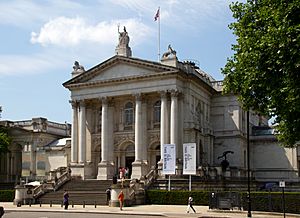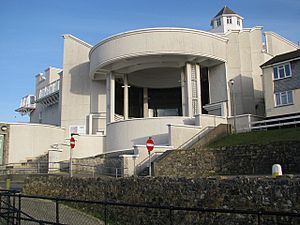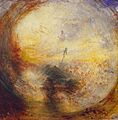Tate facts for kids
Tate is a group of four art galleries in the United Kingdom. They hold the country's collection of British art. They also show modern and contemporary art from around the world. Even though it's not run by the government, a UK government department helps fund it. Many people call it the Tate Museum. The name "Tate" is also used for the group that manages these galleries.
It started in 1897 as the National Gallery of British Art. In 1932, it began to show modern art too. It was then renamed the Tate Gallery. This name honored Henry Tate, a wealthy sugar businessman. He helped start the collection. The first Tate Gallery was in London, where Tate Britain is today.
In 2000, the Tate Gallery became the Tate we know now. It is a network of four museums:
- Tate Britain in London shows British art from 1500 to today.
- Tate Modern, also in London, displays British and international modern and contemporary art from 1900 to today.
- Tate Liverpool (opened in 1988) is like Tate Modern but smaller.
- Tate St Ives in Cornwall (opened in 1993) shows modern art by artists linked to that area.
All four museums share the same art collection. Tate also gives out the annual Turner Prize to a British visual artist. This award happens at Tate Britain every other year.
Contents
How Tate Started and Grew
The first Tate was called the National Gallery of British Art. It was built in London on the site of an old prison. The idea for a national British art gallery came up in the 1820s. Later, in 1847, Robert Vernon gave his art collection to the National Gallery.
Forty years later, Henry Tate offered to pay for a new gallery building. He was a sugar businessman and collected many Victorian artworks. He said he would pay if the government provided the land and running costs. Henry Tate also gave his own collection to the gallery. At first, it only showed modern British art, mostly from the Victorian era. The National Gallery managed it until 1954.
After 1915, the Tate's collection grew to include art from other countries. This happened when a collection of European modern art was given to Tate. Wealthy art dealers also paid for big expansions of the gallery in 1926 and 1937. By the mid-1900s, Tate showed both British art history and international modern art. In 1954, the Tate Gallery became separate from the National Gallery.
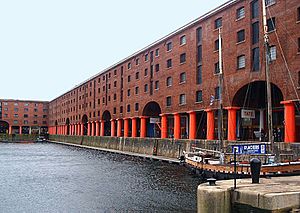
During the 1950s and 1960s, the Tate Gallery hosted many temporary art shows. In 1979, a large new section opened, funded by a Japanese bank. This allowed for bigger exhibitions. In 1987, the Clore Wing opened. It holds many artworks by J. M. W. Turner and has an auditorium.
In 1988, Tate Liverpool opened in northwest England. It shows modern art from the Tate collection and hosts its own exhibitions. In 2007, Tate Liverpool hosted the Turner Prize. This was the first time the prize was held outside London.
In 1993, Tate St Ives opened in Cornwall. It shows art by modern British artists, especially those from the St Ives School. Tate also manages the Barbara Hepworth Museum and Sculpture Garden, which opened in 1980.
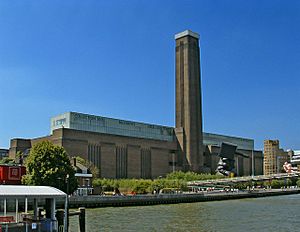
The original London Tate Gallery became too small as its collection grew. So, it made sense to separate the British art from the modern art. Now, they are in different buildings in London. The original gallery is now called Tate Britain. It is the national gallery for British art from 1500 to today. Tate Modern opened in 2000. It is in an old power station by the Thames. It shows the national collection of modern art from 1900 to today.
In the late 2000s, Tate Modern planned a new building. This new part would add more space for art, performances, and learning. It would also create more places for visitors to relax. A generous art supporter, John Studzinski, gave over £6 million to this project. The new part of Tate Modern opened in 2016. It was renamed the Blavatnik Building in 2017. This was after Sir Leonard Blavatnik, who gave a lot of money for its £260 million cost.
Tate Online and Digital Art
Tate Digital is the team that runs Tate's website and other online projects. Since 1998, Tate's website has provided information on all four galleries. It also has details about all the artworks in Tate's collection. You can find research papers and articles from the Tate Etc. magazine there too.
Tate's website has also shown special online art exhibits called Net Art. These are part of Tate's Intermedia Art program for new media art. Since 2000, 13 net art shows have been featured. One, "Tate in Space" (2002), was even nominated for an award.
How Tate is Run and Funded
Tate gets money each year from the UK government's Department for Culture, Media and Sport. A group of trustees manages Tate. They are in charge of running the galleries and choosing the Director.
Maria Balshaw has been the Director of Tate since 2017. She followed Sir Nicholas Serota, who was Director from 1988 to 2017.
Many groups help support Tate. Tate Members pay a yearly fee for benefits like free entry to special exhibitions. There are also Tate Patrons, who pay more, and the Tate Foundation. Many companies also sponsor Tate. Individual art shows often have their own sponsors too.
Tate spends about £1 million each year from its general funds to buy new artworks. Other groups also raise money for new art. These include the Members, Patrons, and American Patrons of Tate. In 2010, a committee was started to buy photographs. In 2012, committees were set up to collect modern art from South Asia, Russia, and Eastern Europe.
Tate's Logo
The Tate logo was designed in 2000. It was part of a plan to make people "look again, think again" about Tate. The museum uses different versions of its logo that look like they are moving in and out of focus. This shows that Tate is always changing but still easy to recognize. A new version of the logo was released in 2016.
Directors of Tate
The person in charge of Tate is called the Director. Before 1917, they were called the Keeper.
- Sir Charles Holroyd (1897 to 1906)
- D. S. MacColl (1906 to 1911)
- Charles Aitken (1911 to 1930)
- James Bolivar Manson (1930 to 1938)
- Sir John Rothenstein (1938 to 1964)
- Sir Norman Reid (1964 to 1979)
- Sir Alan Bowness (1980 to 1988)
- Sir Nicholas Serota (1988 to 2017)
- Maria Balshaw (2017 to present)
Images for kids
-
J. M. W. Turner, 1843, Light and Colour (Goethe's Theory) – The Morning after the Deluge – Moses Writing the Book of Genesis, Tate Britain
-
Robert Delaunay, 1912, Windows Open Simultaneously (First Part, Third Motif), Tate Modern
-
Paul Klee, 1921, A Young Lady's Adventure, Tate Modern
See also
 In Spanish: Tate para niños
In Spanish: Tate para niños
- Tate Etc.
- Turner Prize
- Tate Publishing Ltd, a publisher of art books linked to the Tate Gallery



